The LJS Heritage Trail
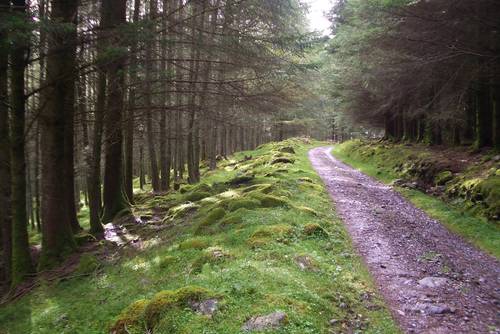
The LJS is a wonderfully diverse and international community, with our own or family roots in countries across the world from Spain to Nigeria, Poland to China, Ukraine to Iraq, and all parts of the United Kingdom. Our community is made up of a classic Jewish mix of backgrounds, whether our backgrounds are in fact Jewish or not. The love and respect for community and core Liberal Jewish values draws us together.
Over the coming months, on The LJS Heritage Trail, members will generously share an insight into their heritage and how each came to the LJS. As the months go on, we will discover the variety of backgrounds that make up our community.
This project forms part of our ongoing recognition and celebration of the full range of diversity and the inclusivity of the LJS. For further information and to take part in other ways, please email office@ljs.org
Hugh Marsden's Story
The family was from Alsace in the mid-1700s, via Holland. Elias Moses is recorded in Bungay in 1786, setting up as silversmith. Isaac Moses, his son, was born in 1808, the additional family name Marsden being added only in 1865, one of the first Jewish families to anglicise the family name, and doing so by adding Marsden – a Yorkshire town where he had business connections. The London Gazette of 1865 noted, ‘Be you Montagu, Marsden or Moses you can change your names but you can’t change your noses.’
E. Moses and Son was founded by Elias, Isaac’s father. In 1829 they opened a shop in Houndsditch, before moving to larger premises at Aldgate in 1832, the largest clothing outlet in England at the time. They opened a further four branches in England and were probably the pre-eminent men's fashion retailer in London, introducing plate glass windows to advertise their wares and large glass atriums to bring natural light into the sales floors. Extra trading hours were made possible with gas lighting, and the introduction of the Singer sewing machine greatly reduced costs and increased output to serve ‘Man & Servant’ at moderate or affordable prices. A resident poet provided amusing ditties on all invoices and advertisements in the many journals of the day and at the Great Exhibition in 1851.
In 1845, nine years after the death of Isaac’s first wife, Rachel (née Hyam) who bore five children, Isaac married Esther Gomes Silva, born in 1825, in Kingston, Jamaica, to a family which had fled the Spanish Inquisition. They moved to London around 1840 and were members of the Bevis Marks synagogue. With Esther, Isaac had thirteen more children and moved to 23 Kensington Palace Gardens. He was a founder member of the St Petersburgh Place Synagogue.
From 1858 Isaac started to invest in property in St John's Wood. In 1860 he purchased the freehold of Lord’s at auction from the Eyre Estate, selling it to the MCC in 1866. His portrait now hangs outside the Long Room in Lord’s.
With his death in 1884 it seems that his vast business empire died with him. There were only four sons, and today just two Marsden great-grandsons and two great-great-grandsons. As LJS members we thus return to our old neighbourhood.
The Story of the Diamonds from Warsaw
My great-grandfather Zyman Diamond, born c1840, was a wood-turner in Warsaw (which had 125,000 Jews by 1850)according to his Naturalisation petition, although I have not found his name in Polish records. A daughter Leah was born there in 1854 to his first wife Miriam, then a son, Isaac, in c1857. Zyman came to London in the 1860s, before the main immigration of the 1890s, possibly due to the uprising in 1863, and he became a woodturner in Bethnal Green, selling turned parts to nearby cabinet makers. He obtained British nationality in 1896, his wife having died in 1871. 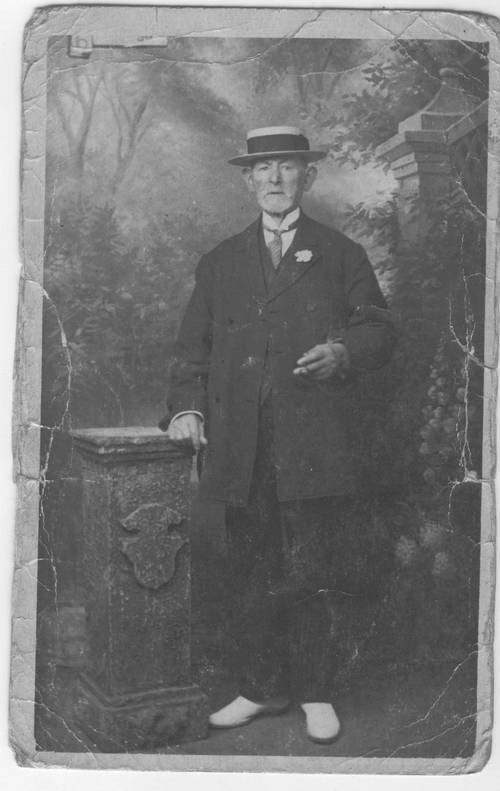
Zyman remarried in in the London Great Synagogue in 1873 to give Isaac, Leah and another daughter a stepmother. His business in various small premises became difficult, and he made arrangements with creditors in 1882. He supported a small stiebel, the New Warsaw Synagogue, as Treasurer, later President, also supporting two benefit societies for Warsaw immigrants, so he kept in touch with his landsmen. He retired from his business in 1902 and moved to Westcliff with his son Isaac in 1908 and died there in 1921. His simple memorial is in Edmonton cemetery (Federation of Synagogues).
His son, Isaac, my grandfather, started his trade in Bethnal Green as a turner and carver, then became a timber merchant with a yard, importing American walnut and mahogany from New York City as The New York Lumber Company or the Anglo-American Timber Company. British nationality was obtained in 1886 at the young age of 25. He moved from Bethnal Green Road, where eight children died of illnesses, to the pleasant suburb of Dalston in 1895. In Westcliff he was Chairman of the Building Committee for the new synagogue. Surviving artefacts are a family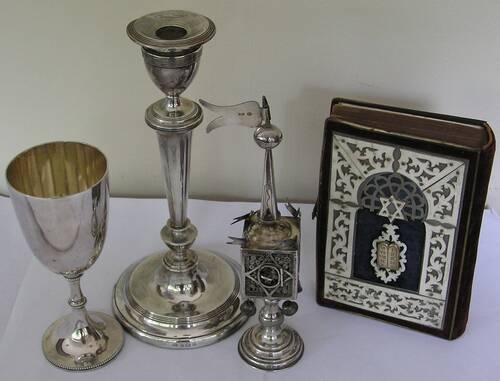 Bible, pair of silver candlesticks, kiddush cups, a Stilton cheese scoop and a 1895 Frankfurt ivory-covered prayer book (on right). His elaborate memorial is in East Ham.
Bible, pair of silver candlesticks, kiddush cups, a Stilton cheese scoop and a 1895 Frankfurt ivory-covered prayer book (on right). His elaborate memorial is in East Ham.
Isaac and his wife Jane had eight surviving children of whom two emigrated to Winnipeg. One of them, Flora Jacobs, had a wedding dress by a leading designer which is now in the Victoria & Albert Museum. My father, born in 1897, was the youngest.
Bob Kirk's story
In 1723, 25-year-old Levy Wolf settled in Berwangen in the Kraichgau (in Baden, just north of the Black Forest), with his wife Sara. Like many of the small Jewish community, he was a cattle dealer and grain merchant – one of the few occupations open to Jews. His sons and grandsons followed him until, five generations later, some emigrated to the USA. Amazingly, in the early 1900s one of them took the name Kirk.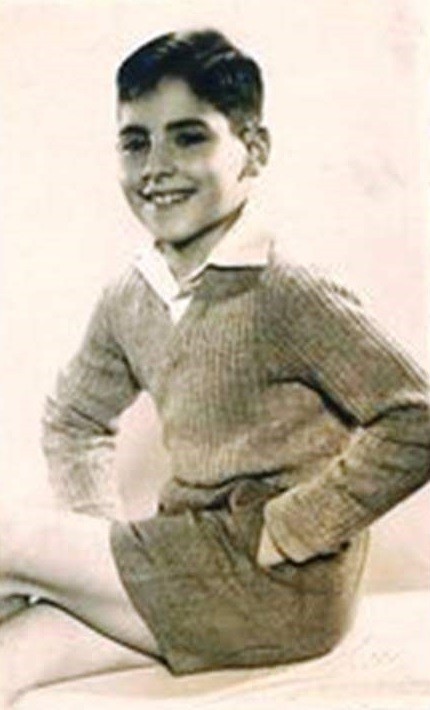
In 1809, surnames became mandatory, and four brothers, Levi Wolf’s descendants, took the name Kirchheimer. Why? No-one knows. There are several villages called Kirchheim in that area, but none with a family connection.
My father (the 7th generation, the eldest of six siblings surviving into adulthood out of eleven) went to school in Heidelberg, then studied textiles in Frankfurt-am-Main, where he met my mother. They married in 1912 and settled in Hanover – mother’s home town. Her father was from Postelberg (now Postoloprty) in Bohemia - then part of the Austrian Empire – and emigrated to Crailsheim in Wuerttemberg, where he settled as a candle and soap maker. Later, he moved to Hanover with his wife and six children, of whom my mother was the youngest. To settle, Dad had to acquire Prussian citizenship – I have his ‘Naturalisation Certificate’.
Dad established a textile business in 1913 – I can’t imagine how it survived the war – Dad served right from the beginning, and was wounded three times (one got a medal for that!). He also acquired the Baden Medal of Merit and an Iron Cross (2nd class).
My elder sister, Helga, was born in 1913, another sister, Lotte, in 1915, sadly died from pneumonia in 1921. Brother Frank (Franz) followed in 1923, and I brought up the rear in 1925.
The advent of Nazism changed everything. Helga emigrated to South Africa, then Brazil; Frank came to the UK in February 1939 on a work permit; I followed in May via Kindertransport. Our parents perished in Latvia. Ann and I met in 1948, married in 1950, and the rest is history…
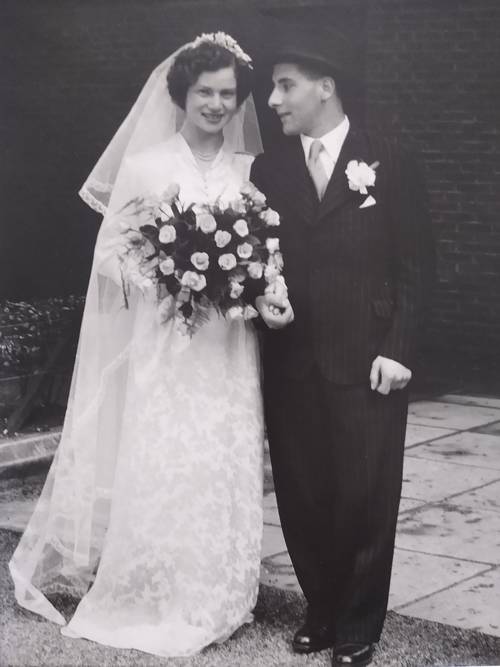
Ann Kirk's story
My father, Franz Kuhn. was born in Breslau in 1896. His father and grandfather, both named Leo, were both general practitioners in the city. Leo II had a country villa in Obernigk, in the mountains.
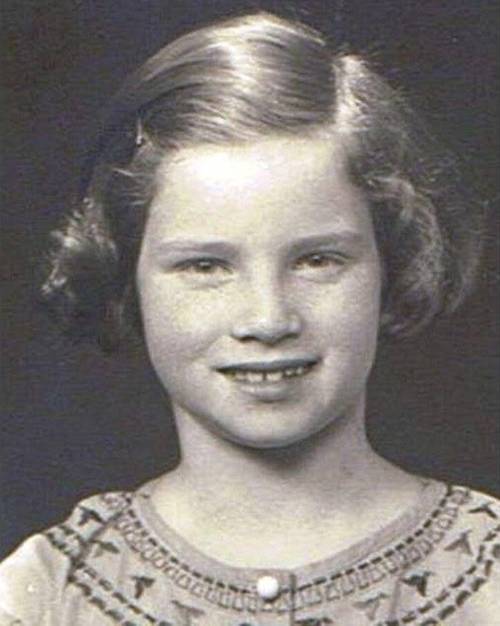 When his wife Martha died, he married his nurse, Meta, who was not Jewish. I used to stay in that villa during school holidays, because both my parents were working, and I have wonderful memories the villa, where I also learned to swim.
When his wife Martha died, he married his nurse, Meta, who was not Jewish. I used to stay in that villa during school holidays, because both my parents were working, and I have wonderful memories the villa, where I also learned to swim.
I had news from Meta during World War II, but she never mentioned my parents – the probably couldn’t have done even if she had known anything. Communications stopped about 1943/4 – due to age - or the Russian advance?
My mother was born in 1899 in Magdeburg, where my grandfather, Gustav Loewenthal, owned a drapers’ shop. Mum and Dad met at business college, and married in 1924. I was born in 1928. I came to London on a Kindertransport in 1939 to be looked after by Millie and Sophie Levy, long-standing members of the LJS, going back to Hill Street days. The last time I heard from my parents was in December 1942 and February 1943. Much later I found out that both had died at Auschwitz.
I met Bob Kirk at a club for young refugees, and we married in 1950.We have two sons, David – a successful accountant – and Andy, who has done well as a travel agent. David married Jennie, a professional flautist and music teacher They have two sons, Benjamin and Joshua, and a daughter, Devora, married to Simon Weaver. Devora and Simon have produced the first of the next generation – two delightful children – Joseph (4) and Sophie (2).
And – guess what – quite recently we discovered that there is a family connection between the Loewenthals and the Kirchheimers, going back two generations. We just haven’t found out yet how it works.
Trixi's Story
I left Hungary with my family in January 1957 as a consequence of the Hungarian uprising against Russian occupation in October 1956.
I was 10 years old at the time. Budapest, where I grew up, was very different from the popular tourist destination that it has become today. In those days the city was just recovering from the Second World War. The Russian army which ‘liberated’ Hungary from the Germans never really left. Hungary became a communist one-party state, one of the USSR’s satellites, firmly behind the Iron Curtain.
I look back on my childhood in Budapest as a blissfully happy one - totally unaware of my family’s Jewish background and of the country’s political situation. My parents considered it safer this way.
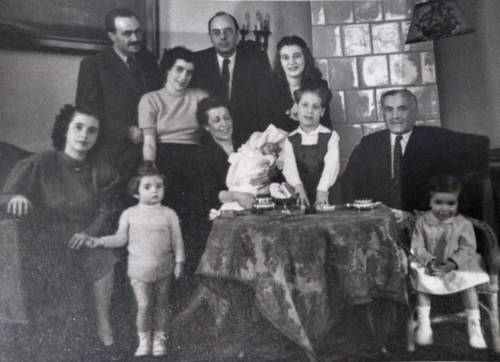 My parents both came from completely assimilated Hungarian middle-class backgrounds. I always think it’s likely that my maiden name, Baracs, was a Hungarian version of the Hebrew word ‘Baruch’.
My parents both came from completely assimilated Hungarian middle-class backgrounds. I always think it’s likely that my maiden name, Baracs, was a Hungarian version of the Hebrew word ‘Baruch’.
Most of my immediate family were fortunate enough to survive the Holocaust. My father was taken away and spent several years in a forced labour camp in Ukraine, and my mother worked on the trams in Budapest with false identity papers. I remember many occasions during my childhood my family referring to relatives and friends as ‘elpusztult’, which in Hungarian means ‘they perished’. As a child it
never occurred to me to question what this meant.
Hungary’s Jewish population before the Second World War was about 800,000, of whom about 365,000 survived the Holocaust. Of those who survived, a large proportion emigrated between 1945 and 1951, and about 20,000, including my family, fled in 1956-7. Hungary’s Jewish population is now estimated at around 48,600.
Since Perestroika in 1989, many Jewish synagogues, especially the Great Synagogue of Budapest, have been restored, and tourists can visit the Budapest ‘ghetto’, which in my childhood was simply where my aunt and uncle lived.
My father always referred to our first five years in the UK as the family’s ‘heroic’ years. He successfully requalified as a solicitor and spent many happy years as a partner with Mishcon de Reya. The family joined the LJS in 1970, the year in which Eric and I were married at the synagogue by Rabbi Dr David Goldstein. We have been LJS members ever since.
The Lee Story
My parents’ families were mandarins at the Qing Court, but imperial records did not survive. The combative Cultural Revolution years saw so much destruction, no-one dared look to the past for fear of being branded ‘anti-revolutionary’. When I enquired about the past, I was often told, ‘What you don’t know won’t hurt you.’
In colonial Hong Kong, the best tactics were to conform, to learn English, to join a church group. Other evidence of the past stayed well hidden away. Objects from around the home hinted at a fascinating lineage; traditions, foods and practices left emotional connections which had to stay in the heart, and any cognitive attempts to find ‘roots’ were stifled by worried elders.
Faith came from my maternal grandmother: there was always a pair of candles on Friday evenings with a glass of wine, and it was the only time we ate bread. It had no name, no label, no fixed prayers, only that the world is broken and it is our duty to fix it.
Every year around Easter we had a huge meal with extended family, when children ate with adults and I was the one who sang. I remember being the only one among my peers to have many ‘new years’: there was the normal January 1 and the Chinese New Year, but there were also the Spring new year and the Fall new year. Somewhere in between there was one day when all adults fasted and children had to eat alone. There were always beautiful candles during the Christmas period. I was raised Christian, and it was not until I studied in New York and Toronto when friends brought me home for holidays that I remarked: wow, Jewish people are just like the Chinese!
I am the generation of the Lost; I have no elders left; Mother went 30 years ago. I cannot lay claim to a certain heritage, not even to any victimhood; my legacy is only embedded in the fleeting impressions of my childhood.
Hence I am grateful that the LJS welcomes me, hence I am gung ho about safeguarding the LJS story and making it accessible to people who want to find their past in the Archives and follow the development of this movement today. I am in the right place, I am calling it home, and I am thankful for it.
If you would like to take part in The LJS Heritage Trail and are an LJS Member or Friend, please submit a 300-350 word account of your family heritage for consideration.
Selected stories will be shared on our website over the coming months with two pieces rotated monthly. Please note that we may not be able to include all submissions. We also reserve the right to edit your piece, with your knowledge and agreement.
Please email office@ljs.org to get in touch.


